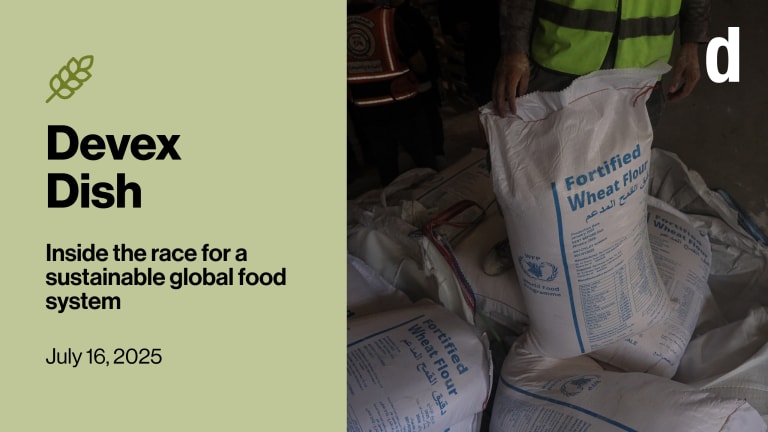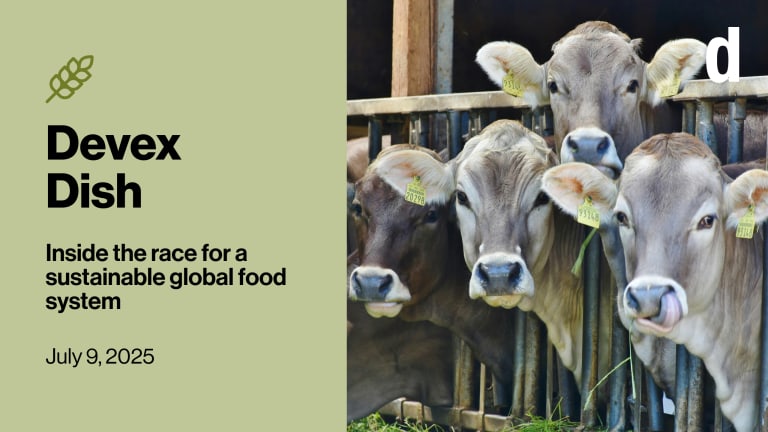
Happy Hump Day, Dish readers! In the Horn of Africa, where herding cattle is a way of life for millions of people, camels might just be the new cows.
The driving force behind the shift is climate change. Droughts have killed well over 1 million livestock in recent years as water sources dried up and left pastures desiccated, leaving animals with little to eat or drink.
Enter the camel, an animal much better adapted to extreme drought: They can go up to two weeks without water, often produce more milk than cows, and can control their body temperatures in response to weather fluctuations.
And a term for their milk is gaining ground: “white gold.”
Leila Abdullahi has been selling camel milk in eastern Kenya for the past five years. She takes part in a regional program that aims to create more sustainable and climate-resilient livelihoods for pastoralists in Kenya, Ethiopia, and Somalia by strengthening livestock markets. The initiative, funded by the Swiss government and implemented by Mercy Corps, hopes to reach some 540,000 people, half of them women.
In this way, the program is also helping women gain access to the camel milk trade, which is on the rise regionally and around the world.
“I get my supplies from camel farmers. After selling I budget the returns to pay school fees, medical bills, and buy food for the family. Yesterday I managed to sell 80 liters of milk,” the 35-year-old mother of seven told Devex contributor David Njagi. Last month he visited the market in the village of Modika in the county of Garissa, where Abdullahi and other women sell camel milk daily.
The market potential is huge. The Horn of Africa is the world’s largest source of camel milk and meat, and it is home to some 60% of the global camel population, David writes.
The advantages of camels have prompted the United Nations to declare 2024 the International Year of Camelids, the term for the family of animals that also includes alpacas, llamas, and vicuñas. In a region being pummeled by climate change, the animals might be a saving grace for pastoralists who have lost entire livelihoods.
Read: Amid climate change in the Horn of Africa, camels pose an opportunity
Explore the visual story: ‘Drought is the enemy’ — The communities fighting hunger in Somaliland
Recipe for success
This bit of wisdom might sound familiar: What gets measured gets done.
A group of governments, NGOs, and U.N. officials are pushing for a new indicator to measure progress toward U.N. Sustainable Development Goal 2 of ending hunger by 2030. They hope it’ll be a turning point for an SDG that is far from likely to be achieved, as Devex contributor Rebecca Root writes.
The proposed new indicator concerns minimum dietary diversity, which is a qualitative measure of food consumption that “reflects household access to a variety of foods, and is also a proxy for nutrient adequacy of the diet of individuals,” according to the Food and Agriculture Organization.
Currently, the SDG monitoring framework contains 13 indicators for SDG2, relating to child stunting, wasting, overweight rates, and anemia. But none measure the quality of diets.
“This is a no-brainer. We have an indicator on hunger and no indicator on diets. That’s a huge gap,” says Ty Beal, senior technical specialist at the Global Alliance for Improved Nutrition, which supports the new indicator and has worked to improve diet quality monitoring globally. “To be able to address zero hunger and malnutrition we have to track what people are eating and how that changes over time.”
Behind this push are the governments of Bangladesh, Brazil, Malawi, and Switzerland, with the support of FAO, the World Health Organization, UNICEF, the International Fund for Agricultural Development, and the World Food Programme. In April they submitted a proposal to the group that ensures the SDG indicator framework is implemented. They hope it’ll make its way to a five-year SDG indicator review set to take place next March.
Read: A new SDG indicator could help end hunger, experts say (Pro)
Background reading: More than 700 million people went hungry last year, UN report says
+ Not yet a Devex Pro member? Access all our exclusive reporting and analyses, data-driven funding insights, members-only events, and the world’s largest global development job board by starting a 15-day free trial today.
Mapping dietary emissions
By now you all know the score: If we’re going to achieve the Paris Agreement and keep the global temperature rise below 1.5 degrees Celsius, we are going to have to reduce greenhouse gas emissions from the agrifood sector. Agrifood-related emissions account for nearly one-third of all greenhouse gasses.
Of course, those emissions are not produced equally. But it turns out, we don’t know a whole lot about just how much emissions specific products and population groups are responsible for.
Enter a group of researchers from across Europe and China who mapped dietary emissions across and within countries. The initial findings, published last week in the journal Nature Climate Change, are not surprising: Populous countries such as India, China, and the United States are the largest contributors to global dietary emissions, though there were wide disparities within those countries that tended to fall along socioeconomic lines. The rich are responsible for more food-related emissions than the poor. The researchers also considered emissions per capita, finding that Bolivia, Luxembourg, and Slovakia had the highest footprints, while Haiti, Yemen, and Burundi had the lowest.
Bringing home the bacon
Your next job?
Individual Consultant: Agriculture-Water-Energy Nexus
AGRA
Burkina Faso | Nigeria | Ethiopia | Tanzania | Kenya
So far, not a huge surprise.
But what to do with all of this information? The researchers considered a scenario where everyone adopted the planetary health diet proposed by the EAT-Lancet Commission, which aims to improve health while limiting the impacts of the food system on the planet. That diet is based on an increase in the consumption of healthy foods, such as vegetables, fruits, whole grains, legumes, and nuts, and a decrease in the consumption of unhealthy foods, such as red meat, sugar, and refined grains.
What researchers found is that the overconsuming groups would save 32.4% of global emissions if they adopted the diet, offsetting the 15.4% increase that would come from communities that aren’t getting enough to eat.
What that means, essentially, is if this shift were to happen, it would mitigate 17% of global dietary emissions while creating greater equity in terms of access to nutritious diets. Not a panacea, for sure, but a step toward the twin goals of reducing emissions and improving nutrition. Like most things, it’s easier said than done.
Related: Researchers unveil a way to monitor transformation of food systems
Chew on this
Yemen is seeing a rapid escalation of acute malnutrition, with famine looming in four districts, according to the U.N. [Integrated Food Security Phase Classification]
A new kind of bond from the World Bank aims to save the Amazon rainforest by linking investors’ financial returns to the amount of carbon removed from the atmosphere. [Bloomberg]
Two multilateral development banks propose using Special Drawing Rights to fund a new G20 anti-hunger alliance. [G20 Brazil]
Andrew Green contributed to this edition of Devex Dish.




